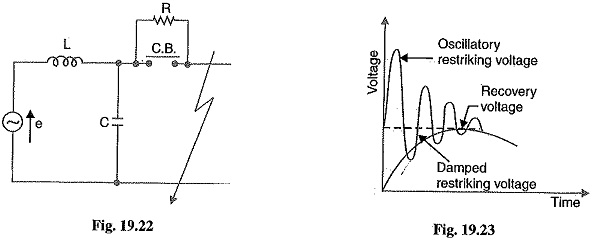Resistance Switching Circuit Breaker:
We already know that current chopping, capacitive current breaking etc. give rise to severe voltage oscillations. These excessive voltage surges during circuit interruption can be prevented by the use of shunt resistance R connected across the circuit breaker contacts as shown in the equivalent circuit in Fig. 19.22. This is known as Resistance Switching Circuit Breaker.
Referring to Fig. 19.22, when a fault occurs, the contacts of the circuit breaker are opened and an arc is struck between the contacts. Since the contacts are shunted by resistance R, a part of arc current flows through this resistance. This results in the decrease of arc current and an increase in the rate of de-ionisation of the arc path. Consequently, the arc resistance is increased. The increased arc resistance leads to a further increase in current through shunt resistance. This process continues until the arc current becomes so small that it fails to maintain the arc. Now, the arc is extinguished and circuit current is interrupted.
The shunt resistor also helps in limiting the oscillatory growth of re-striking voltage. It can be proved mathematically that natural frequency of oscillations of the circuit shown in Fig. 19.22 is given by :
The effect of shunt resistance R is to prevent the oscillatory growth of re-striking voltage and cause it to grow exponentially up to recovery voltage. This is being most effective when the value of R is so chosen that the circuit is critically damped. The value of R required for critical damping is 0.5√L/C. Fig.19.23 shows the oscillatory growth and exponential growth when the circuit is critically damped.
- To sum up, resistors across breaker contacts may be used to perform one or more of the following functions:
- To reduce the rate of rise of re striking voltage and the peak value of re-striking voltage.
- To reduce the voltage surges due to current chopping and capacitive current breaking.
- To ensure even sharing of re-striking voltage transient acorss the various breaks in multi-break circuit breakers.
It may be noted that value of resistance required to perform each function is usually different. However, it is often necessary to compromise and make one resistor do more than one of these functions.

